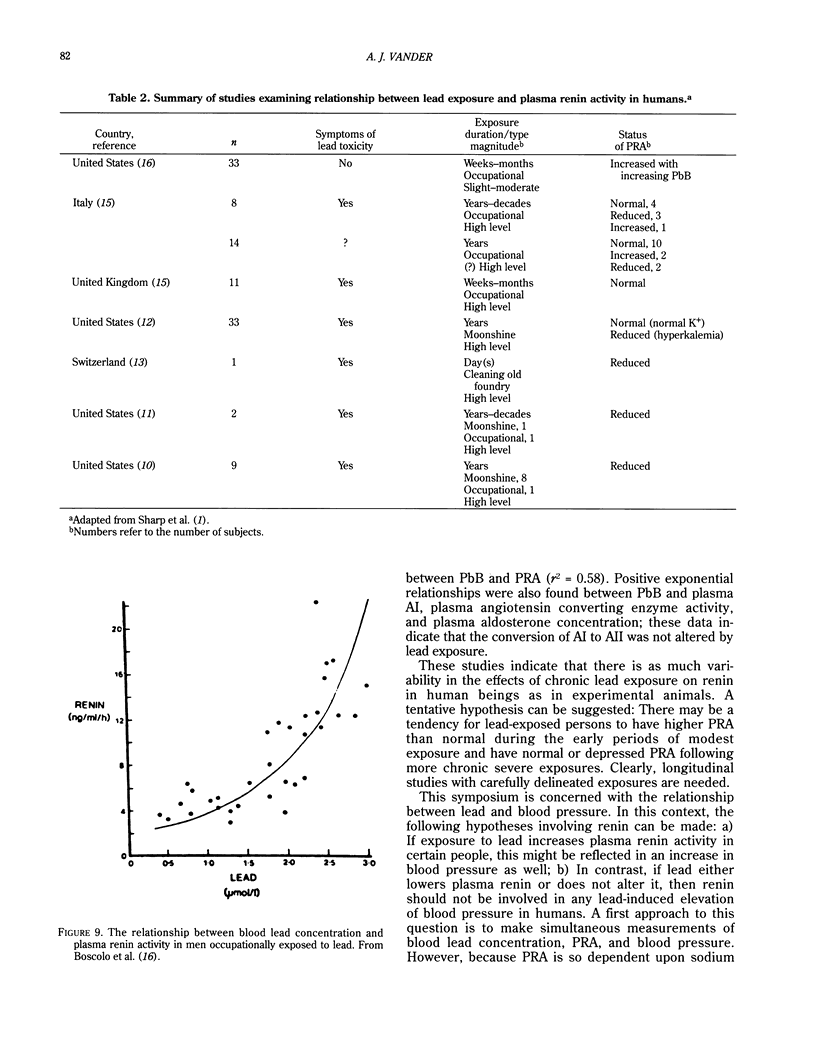Abstract
This paper reviews the chronic effects of lead exposure on the renin-angiotensin system in experimental animals and human beings. In rats, when lead exposure is begun several weeks after birth in doses that cause blood lead concentrations (PbB) of 30 to 40 micrograms/dL, the result is an increase in basal plasma renin activity (PRA) and renal renin concentration, with no change in the metabolic clearance of renin; this is presumptive evidence for increased renin secretion. PRA is also increased in 1-month-old animals whose exposure to lead (in doses that raise PbB to 9 micrograms/dL) was begun in utero. In contrast, older animals whose exposure was begun in utero manifest no change or a decrease in their PRA and renal renin concentration. Regardless of when the exposure is begun, lead can decrease the plasma concentration of angiotensin II at any given PRA, but the dose required for this effect is highly variable. The hypertension induced by lead exposure is associated with low PRA and a normal angiotensin II/PRA ratio. Chronic human exposure to lead also is associated with highly variable changes in PRA from study to study; it has been reported to be decreased under both basal and stimulated conditions, unchanged, or increased in a manner exponentially related to PbB. The human data are consistent with the tentative hypothesis that lead-exposed persons may have higher PRA than normal during the early periods of modest exposure but normal or depressed PRA following more chronic severe exposures. In a small preliminary study, blood lead concentration was found to be higher in high-renin hypertensive persons than in normotensive persons.
Full text
PDF






Selected References
These references are in PubMed. This may not be the complete list of references from this article.
- Bertel O., Bühler F. R., Ott J. Lead-induced hypertension: blunted beta-adrenoceptor-mediated functions. Br Med J. 1978 Mar 4;1(6112):551–551. doi: 10.1136/bmj.1.6112.551. [DOI] [PMC free article] [PubMed] [Google Scholar]
- Boscolo P., Galli G., Iannaccone A., Martino F., Porcelli G., Troncone L. Plasma renin activity and urinary kallikrein excretion in lead-exposed workers as related to hypertension and nephropathy. Life Sci. 1981 Jan 12;28(2):175–184. doi: 10.1016/0024-3205(81)90550-6. [DOI] [PubMed] [Google Scholar]
- Brunner H. R., Laragh J. H., Baer L., Newton M. A., Goodwin F. T., Krakoff L. R., Bard R. H., Bühler F. R. Essential hypertension: renin and aldosterone, heart attack and stroke. N Engl J Med. 1972 Mar 2;286(9):441–449. doi: 10.1056/NEJM197203022860901. [DOI] [PubMed] [Google Scholar]
- Campbell B. C., Beattie A. D., Elliott H. L., Goldberg A., Moore M. R., Beevers D. G., Tree M. Occupational lead exposure and renin release. Arch Environ Health. 1979 Nov-Dec;34(6):439–443. doi: 10.1080/00039896.1979.10667446. [DOI] [PubMed] [Google Scholar]
- Campbell B. C., Meredith P. A., Scott J. J. Lead exposure and changes in the renin-angiotensin-aldosterone system in man. Toxicol Lett. 1985 Apr;25(1):25–32. doi: 10.1016/0378-4274(85)90096-7. [DOI] [PubMed] [Google Scholar]
- Goldman J. M., Vander A. J., Mouw D. R., Keiser J., Nicholls M. G. Multiple short-term effects of lead on the renin-angiotensin system. J Lab Clin Med. 1981 Feb;97(2):251–263. [PubMed] [Google Scholar]
- Gonzalez J. J., Werk E. E., Jr, Thrasher K., Behar R., Loadholt C. B. Renin aldosterone system and potassium levels in chronic lead intoxication. South Med J. 1979 Apr;72(4):433-6, 440. doi: 10.1097/00007611-197904000-00018. [DOI] [PubMed] [Google Scholar]
- Keiser J. A., Vander A. J., Germain C. L. Clearance of renin in unanesthetized rats: effects of chronic lead exposure. Toxicol Appl Pharmacol. 1983 Jun 15;69(1):127–137. doi: 10.1016/0041-008x(83)90128-x. [DOI] [PubMed] [Google Scholar]
- Keiser J. A., Vander A. J., Germain C. L. Effects of lead on the secretion and disappearance of renin in rabbits. Toxicol Appl Pharmacol. 1983 Jun 15;69(1):117–126. doi: 10.1016/0041-008x(83)90127-8. [DOI] [PubMed] [Google Scholar]
- McAllister R. G., Jr, Michelakis A. M., Sandstead H. H. Plasma renin activity in chronic plumbism. Effect of treatment. Arch Intern Med. 1971 May;127(5):919–923. [PubMed] [Google Scholar]
- Sandstead H. H., Michelakis A. M., Temple T. E. Lead intoxication: its effect on the renin-aldosterone response to sodium deprivation. Arch Environ Health. 1970 Mar;20(3):356–363. doi: 10.1080/00039896.1970.10665604. [DOI] [PubMed] [Google Scholar]
- Sharp D. S., Becker C. E., Smith A. H. Chronic low-level lead exposure. Its role in the pathogenesis of hypertension. Med Toxicol. 1987 May-Jun;2(3):210–232. doi: 10.1007/BF03259865. [DOI] [PubMed] [Google Scholar]
- Victery W. Evidence for effects of chronic lead exposure on blood pressure in experimental animals: an overview. Environ Health Perspect. 1988 Jun;78:71–76. doi: 10.1289/ehp.887871. [DOI] [PMC free article] [PubMed] [Google Scholar]
- Victery W., Vander A. J., Markel H., Katzman L., Shulak J. M., Germain C. Lead exposure, begun in utero, decreases renin and angiotensin II in adult rats. Proc Soc Exp Biol Med. 1982 May;170(1):63–67. doi: 10.3181/00379727-170-41398. [DOI] [PubMed] [Google Scholar]
- Victery W., Vander A. J., Shulak J. M., Schoeps P., Julius S. Lead, hypertension, and the renin-angiotensin system in rats. J Lab Clin Med. 1982 Mar;99(3):354–362. [PubMed] [Google Scholar]


